Since I am old and cantankerous, I believe I am allowed to select my favorite cat breeds from the 200+ different ones that can be found in this world of ours. Here are pictures and information about the ones I like best. If you have a favorite that is not on this list, let me know in comments, and I will research it for you and add the information to this site. Meanwhile, check out this post to see if your favorite cat is there.
BIRMAN
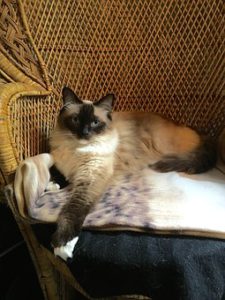
The Birman is the sacred cat of Burma. Though its origin is uncertain, it may come from Southeast Asia, or possibly from France. The Birman is long-haired, but different from the Himalayan because it has four white socks on its feet. Its coat is less fluffy than the Himalayan. It has sapphire-blue eyes and a fluffy tail.
For a long time I thought my two wild cat sisters, Poo and Lou, were Birman because their shoes and socks were white. However, when researching, I found a cat that looks exactly like my twins. It has a coat and markings just like a seal-point Siamese, but with white feet. It is called a Snow Shoe cat. My two cats also had a white chin. To see a picture of them, go to the post titled “The Many Ways Cats Show Love to their Humans.”
Back to Burma: According to Khmer legend, before the time of Buddha, these people built many temples to their gods. One of these, named Temple of Lao-Lsun, kept 100 pure white cats. One white cat, named Sinh, was the companion of an old priest.
One night, Thai raiders attacked the temple and killed the old priest. Sinh jumped on the body of his master. It was believed that the soul of the old priest entered the cat, as its coat turned the same golden color as the priest’s beard, and its eyes became a sapphire blue, like that of their goddess. The cat’s legs turned brown except where they rested on the priest’s body. These remained white.
The next morning, all the other cats had gone through the same transformation. Now the priests guarded these sacred golden cats, believing they all contained the souls of priests.
HIMALAYAN
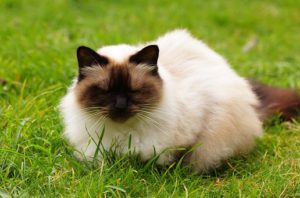
This cat evolved from a breeding experiment. The intention was to breed a Siamese-patterned cat with Persian coloring and body type. In North America, the breed became known as the Himalayan.
The first of these cross-bred cats was born in the United States in 1935. However, it was only one cat. Then, in the 1950s a female cat was successfully cross-bred with a Persian, and produced what they sought: a long-haired cat with Siamese coloring and the body type of the Persian. These cats were shown for the first time in 1957, and caused a sensation. By 1961, the breed was recognized.
Today, the Himalayan cat can be found with many Siamese colors. Himalayans are very recognizable, having a wide head, small nose, short legs and tail, and a soft, silky coat.
Though varying in temperament, the Himalayan is considered to be less demanding and boisterous than the Siamese.
Females may bear litters as early as eight months, but with smaller litters, usually only one to three kittens. At birth, the kittens have fluffy fur and are all creamy-white. The point color begins to appear after a few days.
SIAMESE
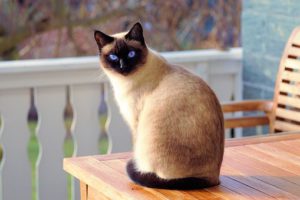
Now that we have discussed two breeds that have some Siamese in their genetic make-up, let’s take a look at the Siamese as a breed.
This breed was the first to be developed with the traditional coloring that we now think of as Siamese. A specific gene causes the traditional pattern. Their eyes are bright blue. Their “points,” which refer to their mask, ears, tail, and legs, can be quite varied in color, as there are 20 types of point colors.
In the Siamese pattern, the color pigments appear in the points. I was interested to learn that the amount of color pigment produced depends on the cat’s skin temperature. The lower the temperature, the more pigment is produced. Therefore, kittens raised in a cooler climate often develop darker coats. The cat’s body color will vary with the point color.
I did not find much information regarding temperament in the book I researched. Are all Siamese cats talkers? My Siamese, Maxine, was like a person who never shut up. She “talked” incessantly. If I called my house from work, I could hear her talking in the background.
TABBY
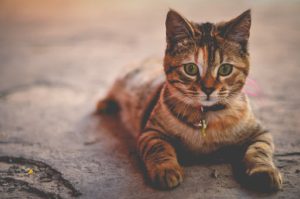
I thought a tabby was a breed of cat, but found in my research that it is not a breed, but a color pattern. So, I guess I lied — there are only nine breeds of cats listed here. From an article online at a site called “The Spruce Pets,” I learned that the tabby is most often striped. However, it can also have whorls or spots.
The gene for the tabby pattern can be found in all domestic cats. Many times, tabby patterns can be seen in the American Shorthair. The tabby often has a whorl pattern that ends in a “target” on its side. A very common pattern includes striped rings around the tail, a striped “necklace” and bands of solid or broken stripes running down its sides.
Tabbies can also be spotted. An example is the American Bobtail. Another cat with classic tabby markings is the Abyssinian, which can have a spotted tabby pattern.
On the website, Catster.com, is a list of the five patterns of tabbies. They are as follows:
- Classic — Bold swirling patterns
- Mackerel — Narrow stripes running parallel down its sides; what some people call a “tiger cat”
- Spotted tabby — Large or small spots all over its sides
- Ticked tabby — The Abyssinian is an example. It has tabby markings on its face
- Patched tabby — Separate markings of brown and red tabby on the same animal. This one is sometimes called the tortoiseshell tabby.
In the article I read online from “The Spruce Pets,” it listed 25 breeds that can have a tabby pattern.
You have undoubtedly noticed the “M” on the forehead of many cats. That is a tabby marking. There is a neat legend about the origin of the “M”. It seems that when baby Jesus was lying in his manger, he was cold and fussy. A tabby cat came and nestled close to the baby, warming him and soothing him with its purr. Out of gratitude, Mary placed her initial, “M”, on the cat’s forehead.
PERSIAN
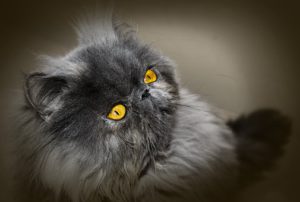
The Persian probably originated in Asia Minor. It can be found in a profusion of colors. It has a long coat. Persians are heavier, larger-headed and have a more compact body type than Angoras. Besides their massive, compact body, they have short legs and the head is broad and round. Their ears are small and rounded. The coat is long, silky and full.
In Britain, they were simply referred to as Longhairs; however, in North America, Persian is the official name. Persians were introduced to America from Europe toward the end of the 19th century.
Color variety can include whites, blacks, blues, chocolates, lilacs, reds and creams. These many color variations came about because of mating different colors. The white Persians were the first large-headed cats in Europe. However, these white cats were often born deaf. Judicious breeding has eliminated this problem.
It seems these cats are bred more for show. One of the most beautiful Persians is the smoke Persian. This cat looks almost like it is a solid color, except for some silver in the coat.
Persian cats are known for their placid, gentle temperament and for their aptitude for adjusting to a new environment. They have quiet, melodious voices, in comparison to the strident voice of the Siamese.
Though the kittens are born with a short coat, by the age of six weeks, the longer coat begins to develop. Persians require daily grooming so tangles do not develop in the fine, light hair. As the cat likes to be groomed, it can enhance the bonding process with their human.
ANGORA
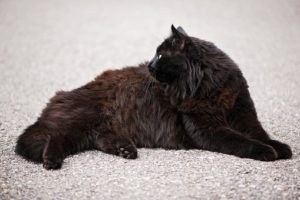
Angoras are one of the most ancient breeds, with ancestors in Turkey. A beautiful animal, it has a lean body and a long, silky coat. It is probable that a long-coat gene spread to a group of cats with a lithe body. Since there was little opportunity to breed outside the group, the long-haired coat became a fixed characteristic.
Until the 1950s they could not compete with the more popular Persian, and were virtually unknown outside Turkey. In their country of origin, they could be found in many colors.
Angoras were named after the old city of Angora (now Ankara.) A breeding variety developed in the area of Lake Van. These cats were red and white, with the red color restricted to the areas around the ears and on the tail. Besides being beautiful, they were known for their habit of swimming in shallow pools and streams.
These cats have gentle dispositions. They are athletic in play. The females can produce large litters, though the normal litter is around four. In summer, they moult heavily, making them look like short-haired cats with fluffy tails. The winter coat grows in very quickly, and because they lack the fluffy undercoat, they are much easier to groom than Persians.
MAINE COON
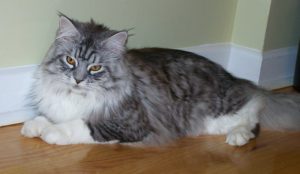
One of the oldest natural breeds in North America, this cat is generally regarded as being a native of the state of Maine.
By legend, though a biological impossibility, it was thought that these cats originated from matings between semi-wild domestic cats and raccoons. They have a bushy tail and raccoon-like dark tabby markings; hence, they became known by the name of “Maine Coon.”
Hardy and handsome, they have a rugged coat and build, able to withstand hard winters. They are one of the largest breeds of cats, physically. They stand relatively tall; they are long-bodied. The coat is long and flowing.
Maine Coon cats can be found in a wide variety of colors, but the most popular remains the rich, warm brown tabby, with a pattern similar to that of the raccoon. They have an amiable disposition.
They are quite different from the Persian. Their head is much longer, with high cheekbones and large, well-tubed ears. They are broad-chested, with legs and tail considerably longer than in a Persian.
The Maine Coon develops relatively slowly. It does not reach full size until it is four years old. The cat has a clown-like personality and amusing habits and tricks. Its coat is easily groomed.
Litters are not large, most common being two kittens, though the mother can have up to four. Because of the variety of coat colors, many carry several color genes, and every kitten in the litter may be different.
EUROPEAN SHORTHAIR
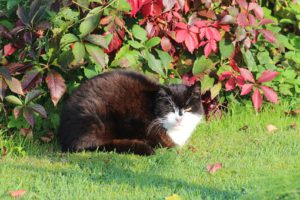
These cats started as the British Shorthair. They are compact, well-balanced and powerful. The head is round, with a good width between the ears. Their stockiness betrays their humble origins, as they were developed as a non-pedigreed pet or working cat. Their main purpose originally was to hunt vermin.
Their hardiness and stamina developed from generations of life in all kinds of weather. They are easy to raise and care for. They are well-suited to family life, being less excitable than many purebreds. Their short coat causes less problems than do the coats of long-haired cats. They are a solid color, with the blue (bluish-grey) often being the most prized.
The British were very proud of their short-haired cats. In the late 1800s they were the most important breed, before other, more exotic breeds were developed. The British were the first to standardize the breed, even though it spread into Europe to gain the name of European Shorthair.
The European Shorthair suffered during World War II, with very few of the pedigreed males remaining alive. Careful breeding brought the line back. Owners tried breeding the Shorthair with Persians, but the cat didn’t have the standard straight nose. Persian mating resulted in a coat change. Though still short-haired, the coat was now an intermediate-length with a fluffy texture.
Tabby patterns, especially silver, were popular, though several tabby patterns were developed. One of the most successful was a spotted tabby, developed in colors such as cream, blue, and lilac.
AMERICAN SHORTHAIR
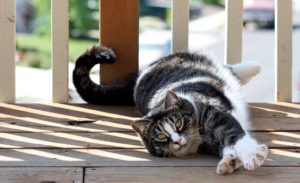
It is possible that these cats arrived in North America aboard the Mayflower. They earned their keep as hunters of vermin. Because of the tough conditions under which they lived, in particular the harsh winters, the American Shorthair is exceptionally strong and hardy.
The history of the American Shorthair dates from 1900 or 1901, when a pedigreed red tabby was sent from England to an American cat lover. Thus, the first American Shorthair was actually a British Shorthair. The first American member of the breed was a male smoke color, born in 1904.
These cats became known as the Domestic Shorthair, and were bred in a variety of colors. By the late 1950s the breeders listed 50 Domestic Shorthairs. Finally, in 1966, the breed was named the American Shorthair, and has now developed into a cat that takes some top awards at cat shows.
The animal is medium to large in size, with a muscular body and a very hard, short coat. They are noted for their good temperament, intelligence, and hunting ability. The cat is easy to feed and rear. Average litter size is four.
The best-known American Shorthairs were silver tabbies, often with classic “mackerel” markings (a tortoiseshell pattern.)
This cat is lithe enough to stalk prey and powerful enough to make the kill easily. The legs are long enough to cope with any terrain and heavy and muscular enough to make high leaps. The cat has a long face, so he can grasp prey easily with his teeth. The American Shorthair is a cat athlete.
I was fortunate to have an American Shorthair as my only companion for 12 years of his life. He was a tuxedo cat. I looked up “tuxedo cats” and found that the coloring appears in many breeds. Carlos was black with a perfect white vest that came to a point at the “lapel”, a white tummy, white feet, and a white blaze. He was an outstanding example of the American Shorthair breed. His favorite hunting prey were rabbits. He could kill a full-grown rabbit, and would carry it home in his mouth, dragging it, while straddling the rabbit with his front legs. He was an amazing cat.
RUSSIAN BLUE
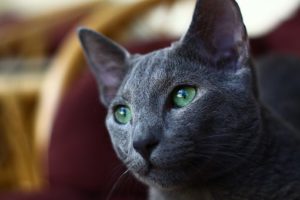
The Russian Blue breed is that shade of dark grey that has a bluish color. There is a silver sheen to his fur, and his eyes are brilliant green. It is believed that the cat originated at the White Sea port of Archangels.
This breed did not become a separate class until 1912. Then in the 1940s and 1950s, Scandinavian breeders began to develop this classification. In 1965, the standard for the Russian Blue was coordinated, in an attempt to return the strain to the previous characteristics of the breed.
The head has the shape of a short wedge, with prominent whisker pads and upright ears. The most distinctive feature has always been its double coat: short, soft, silky and upstanding, like the coat of a seal or a beaver, and with the medium-blue color. As the silver tipping of the guard hairs reflect the light, it gives the coat a silvery sheen.
These cats are very affectionate toward their owners and each other. They make good parents. Litters run to around four kittens. They can be raised with relative ease. They tend to be quiet-voiced. Because of their dense, thick coat, they are very hardy.
KUDOS TO MY MAIN SOURCE

I did most of my research in my favorite cat book, The Book of the Cat, by Michael Wright and Sally Waters. It is a very comprehensive book of information on cats, and I recommend it, if you need such a volume. In it, you will find much more than just my ten favorite cat breeds, as they cover several more, and a multitude of other topics as well. You can buy your copy this very minute at Amazon.
Please note: As an Amazon associate, I earn from qualifying purchases.)


I just love cats, I have three myself, I think they look like Tabby. I find cats to be one of the most mysterious animals. Though not as loyal as dogs I like their independence, instincts, agility and impeccable grooming regime; its no wonder they have 9 lives.
They can also get into dangerous mischief because of their curiosity instinct, guess thats why we say “Curiosity killed the cat”.
Thanks for your comments. I like dogs, too, but don’t agree about loyalty. Dogs and cats have different personalities, and thus express things differently. When a cat bonds with its owner, though it remains independent, its loyalty will never waver. A cat, and a dog, too, when they decide you are family, love unconditionally. That love just looks different in different creatures.
I grew up with a Himalayan named Frankie, he was a really sweet cat. Thanks for such an informative article, it was a great read.
It’s nice to hear that a reader found the article informative. Thanks so much for the comment. Himalayans are such beautiful animals. Cherish your cat memories.
Wow so many amazing moggies. This website was made for me. I have four cats at the moment – two tabby, one long haired grey who may have maine coon in him or Russian Blue, he was a feral so nobody knows, and my eldest a blue tortie. I couldn’t imagine life without them. I love your title by the way.
Thanks so much for your comment. Is “moggies” a UK word for cats?
It is really nice to share this site with other cat lovers. I am so glad you liked it. If you’d ever like to pass on stories about your cats, please send them. We who love these furry babies will enjoy them.
Cats are indeed majestic and lovely. My parents have 5 cats. I do not know their breed but I know 1 of them was the American Shorthair, three of them are all black like silky black and the last one has a variety of colors in its fur.
They managed to live together in harmony after a few weeks of bringing them from separate shelters.
They are all so big now and very adorable. Only one of the Silky black furs liked me though but the rest will rally up on my feet when it is time to eat.
Thank you for this, and now I know more of the breeds thanks to you 🙂
It’s so nice to connect with others who love cats. They can be such entertaining friends! Thanks for your comments; hope you will visit the site again.
My wife’s family always loved Norwegian Forest Cats which look a lot like Main Coons. They aren’t afraid of water and their history goes way back to Leif Erikson. My wife however, had a Calico that lived up to 21 years…in human years. She was probably the smartest cat I ever met and was like the Lassie of cats.
Thank you for your comment, Bruce. Yes, the Norwegian Forest Cat has a strong resemblance and similar characteristics to the Maine Coon. It is another very beautiful animal, intelligent and playful. Its ancestors were hardy outdoor cats, and I am sure you are right…their history went back to old Leif himself. Breeders began developing a pedigree breed of this fabulous animal as early as the 1930s. Cats are wonderful creatures! Your wife was so lucky to keep her calico with her for 21 years. It saddens me when we have to lose them so soon!
Awww, I love Maine Coon! Isn’t it amazing that a big cat such as it is able to walk so gracefully and quietly? Definitely my favourite breed!
But at the same time, I don’t really like seeing breeders selecting heavily on the cats’ genetics. As we have so many genetic related problems with dogs due to selective breeding, I think we should definitely learn how to love our cats by heart, not their appearance, especially when we still have the chance!
Thanks so much for your comment, Crystal Lim. The Maine Coon is an amazing animal. I had a friend who had one — very smart, and so beautiful!
I think you have given me an idea for a new article. I agree with you regarding cats’ genetics. I am sure it is a good idea to select the qualities which optimize the traits of a particular breed, but in the process we might “select out” some qualities that could be outstanding. I’ll do some research and see if I can find some pros and cons. I myself have never had a pedigreed animal, and have certainly been satisfied with my cat companions. Yep, we need to love them for who they are.
What a fun post on cats. I love them but have never been able to have them as pets as one of my daughters is allergic to them. I have dogs instead. It’s amazing how different cats are from dogs. My friend growing up had Tabby cats and I loved playing with with. I had no idea there were so many different breeds. Thanks for sharing your knowledge.
Holly, I appreciate your comment. I am sad for your daughter, as all of you are missing a lot of cat pleasure. Dogs are great, too; they are just different. Thanks for the visit — hope you come again!
Hello Fran,
I love cats in all breeds, colors and ages but I am partial to my kids. I have a red, American Short Hair tabby boy, a gorgeous slate grey French Chartreux, a Norwegian Forest Cat and a “calico” whom I have been told should actually be called a “Tortishell With White”. That is the more accurate name for her fur colors. She is a medium hair. They are all rescues so they have no pedigree. The veteranarians always comment on what gorgeous cats they are though and we certainly got some amazing kitties.
It would seem strange to have breeds such as a French Chartreux at the pound, but I suspect she was from a breeder who sold her off cheap since she has gorgeous green eyes. They are immaculate against her silvery grey fur but the breed standard for the Chartreux is gold eyes! She was with a family who couldn’t keep her anymore and I found her at the pound!
The Norwegian Forest Cat boy is gorgeous! He is huge at about 16 pounds with a mane and busy tail. He is all orange and white. He is so affectionate and loyal. He is like a dog and likes to be near me all the time. He used to pee all over though and I suspect that may be why he was dumped. We found products for his anxiety and now he is perfect and happy. These were the cats of the Vikings and are a very hardy breed. It is thought the Maine Coon may be descended from them.
The calico girl is 14 years old and we just adopted her this spring. She is amazingly spry and healthy and even has good teeth. She appears healthier than the other 3 even though she is much older. She is very sweet, dainty, puffy soft and petite.
Our first boy, the orange/red tabby is our baby. He is the cat that made my husband love cats. My husband was a big, tough Marine and thought he just liked dogs. Now he is the biggest cat lover I have ever met! He cuddles them, carries them, kisses them and makes sure they have everything they need. This tabby boy is like an emotional support kitty and helps my husband with stress and PTSD.
Thanks for highlighting some of the great cat breeds!
Jessica
Thank you, Jessica, for telling me about your cat family. I really enjoy reading about other peoples’ cat experiences, and about their special babies. They bring us such happiness, and really don’t ask for more than some food and a warm bed in return. I wish them the best of health, and I can tell they are enjoying the best of care.
Love learning all of the history of cat breeds and how they all evolved. I have never had a long haired cat. My last cat was a short hair and my two boys now are tabbies. I don’t think my allergies would fair well, but I am always attracted to the long hair breeds. Thanks for sharing.
You are so welcome, Susanne. Thanks for your comment. There will be more information on cat breeds in the future, so be watching for it. I love long-haired cats also, but have usually had short hairs. They are easier to take care of. That long hair can get so tangled, and sometimes it is too much work even for a sandy cat tongue to straighten out. I have heard that the Norwegian Forest cat, though a long-hair, does not stir up the allergies. That cat needs investigating, as I’d like to learn more.